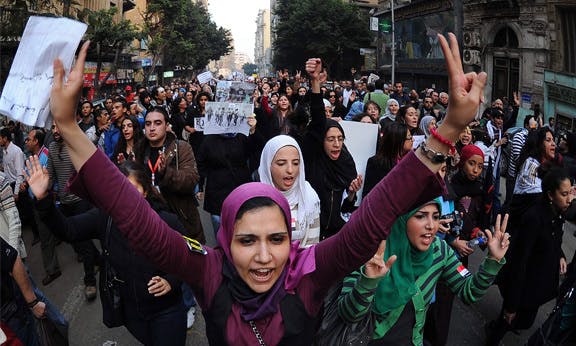How ideas can change in struggle

Marx argued that the only road to socialism was via workers’ revolution. But he acknowledged that, for most of the time, workers are dominated by capitalist ideas and that “the alteration of people on a mass scale is necessary”.
From his experience in workers’ struggles, he concluded that that “can only take place in a practical movement, a revolution; the revolution is necessary, therefore, not only because the ruling class cannot be overthrown in any other way, but also because the class overthrowing it can only in a revolution succeed in ridding itself of all the muck of ages and become fitted to found society anew”.
It’s easy to be sceptical when the level of class struggle is low. But capitalism wrecks people’s lives all the time, so there’s always the possibility of protest and struggle.
Workers, the poor and oppressed again and again have fought for their rights; they’ve tried to overthrow governments many times. These struggles have left us a rich history that confirms Marx’s words.
Struggle changes people. The bigger and longer a struggle, the more profound are the changes.
For example, British coal miners were on strike for a year in 1984-5. Their towns were occupied by riot police who bullied their children and batoned peaceful pickets. Comparing this thuggery with TV scenes of British soldiers rampaging in Northern Ireland, many of them began to support the Irish republican struggle. They embraced the gay liberation movement after gays and lesbians toured a pink bus to support the strike.
The dynamic of revolution is qualitatively more profound than individual strikes and can be unpredictable.
In January 1905, workers staged a procession to the Russian tsar’s palace, believing that he would listen to their grievances. His troops massacred hundreds of them and turned protest into revolution.
Workers formed soviets – city-wide committees elected in workplaces, the like of which had never been seen before. They acted like a workers’ government, challenging the tsar for power. Lenin observed:
“The masses … [who] have often been ignored and even despised by superficial observers … are learning in practice … taking their first tentative steps, feeling their way, defining their objectives, testing themselves and the theories of all their ideologists.”
Every chronicler of revolutions has remarked on the joyful atmosphere, how political consciousness can develop in great leaps in weeks or even days, the explosion of creativity and organisational capacities of masses of people once they move into action.
In the 1917 Russian revolution, John Reed, a US author, wrote about semi-literate workers and soldiers thirsting for revolutionary newspapers, standing for hours listening to orators, debating what was to be done.
When general Kornilov tried to establish a military dictatorship in August, workers and soldiers displayed amazing organisational talent. They disrupted his lines of communications and tore up railway tracks, stopping his advance on Petrograd. This convinced them that the soviets needed to take power if they were to achieve the aims of their revolution for land, bread and peace, which they did in October.
Antonio Gramsci wrote about mass occupations of the factories in Italy in 1921:
“[O]ld workers, who seemed broken down by decades upon decades of oppression and exploitation, [stood] upright even in a physical sense during the period of the occupation – [they developed] fantastic activities: suggesting, helping, always active day and night.
“It was necessary to see these and other sights, in order to be convinced how limitless the latent powers of the masses are, and how they are revealed and develop swiftly as soon as the conviction takes root among the masses that they are the arbiters and masters of their own destinies.”
Only five years ago, US socialist Ahmed Shawki wrote about his experience during the “Arab Spring”:
“[Egypt is] a society where the feeling of any kind of pride in being an Arab or an Egyptian … was crushed out of people as a result of the peace with Israel on the one hand, neoliberalism on the other hand, the servile relationship of the Mubarak regime to the US on a third.
“So this is one of the most spectacular aspects of what’s happened in Egypt, as in Tunisia and as in democratic revolutions historically – the return of a sense of pride … You can see just in the way people comport themselves that people have new expectations for their future.”
Women gave speeches, led protests and held interviews with the international media. They told how they felt safe from sexual violence for the first time among the masses in Cairo’s central square. The old, oppressive attitudes were pushed aside by the desire for solidarity in the struggle. Abdul Latif, a 27-year-old writer, told a journalist:
“I never dreamed in my wildest dreams that we would be talking to a woman in a full veil in Tahrir Square. A secular artist is having a political debate with a fully veiled lady and having a meaningful conversation. What’s the world coming to?”
Indeed.
However, it is not inevitable that any struggle will win, or even that revolutionary consciousness will flourish. There are always debates, always some who have experience of strikes and protests from which they have drawn political lessons; and some who drag behind, finding it hard to break from old ideas and habits.
In Poland in 1982, workers’ councils were organising food in cooperation with peasants, running the public transport system and acting like a government. But influential intellectuals who, it was assumed, knew more about politics than ordinary workers, argued for a “self-limiting revolution”. The result was hesitations and doubts about their own legitimacy when the brutal Stalinist state cracked down, leading to defeat.
That’s why any movement capable of overthrowing capitalism will need to be led by activists who genuinely believe in the ability of workers to change sufficiently to build a new, socialist society. They will have to understand that only through their own activity will workers come to believe it themselves.